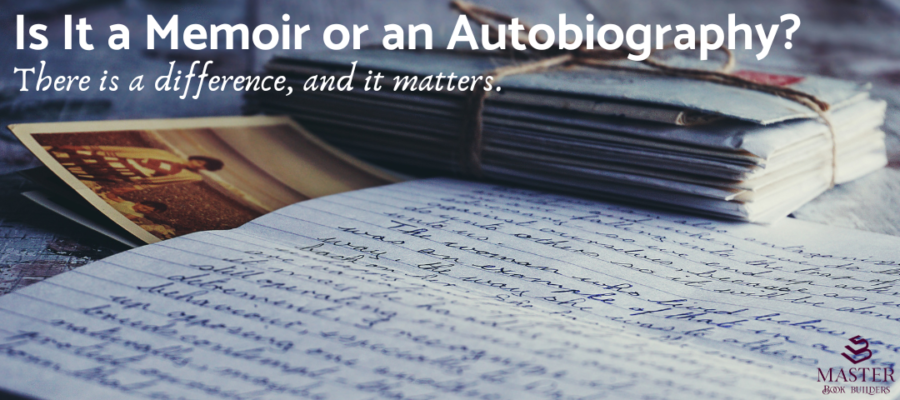Is It a Memoir or an Autobiography? There Is a Difference, and It Matters
At MBB we work with all kinds of writers: fiction, nonfiction, and memoir. To date, we have not worked with autobiographers, but we are open to it.
I chose this topic to write about this week because too many people do not understand the distinction between these two genres. They are similar but not the same. It’s like the difference between a carefully but beautifully crafted photo album and a detailed family archive.
The photo album brings out the stories and emotions one felt during the moment the camera was clicked. The family archive, while it may also have photos, is a narrative about what happened, a documentation of the life shown.
Both require storytelling. Both require attention to detail. Both are meant to engage the reader.
Let’s begin with an explanation of the core differences between a memoir and an autobiography.
A memoir is the tale of your own hero’s journey
American mythologist Joseph Campbell divided the hero’s journey into three stages—separation, initiation, and return—but there are substages within those three major stages. (You can find a graphic demonstrating the whole hero’s journey here.)
Stephen King’s memoir, On Writing, is a great example of a memoir that encompassed most of the author’s life but was based on the theme of writing and how his writing made him a better human being.
“Memoirs focus more on the way the author thinks, feels, and reacts to the situations they’re writing about. It’s an immersive reading experience for the audience. They will get to know the author in an intimate way,” say The Urban Writers.
Because a memoir is focused more on the author’s perception of and reactions to what is happening around them, there’s less emphasis on strictly factual writing. That said, it is helpful to the reader to ground a memoir with some factual “set points.” If you remember a story in your family about your house burning down when you were too young to remember the actual event, for example, you may decide to check in the archives of local newspapers to see if there’s any mention of it. This would also ensure that the date you were told by your parents or whomever told you is accurate.
Memoirs do use a lot of the same writing techniques used in writing novels and other works of fiction. You’ll recognize a story arc, vivid storytelling and description, and, in a well-written memoir, a lot of emotional depth as well. In her book, The Art of Memoir Mary Karrsays,
“To watch someone scrutinize a painful history in depth … is to witness not inconsiderable pain. You have to lance a boil and suffer its stench as infection drains off.”
At Master Book Builders, we refer to the story arc in our nonfiction business books as the throughline—the common theme around which your narrative is built.
One thing some writers don’t seem to know is that memoirs do not need to be written in chronological order. Memoirists use fiction techniques like flashbacks, and they often write a chapter about what’s going on in the present and then flip back and forth to incidents through time to support the flow of the author’s story.
An autobiography is the complete story of your life
While a memoir is a slice of the pie of your life, with a focus on the flavor, an autobiography is more comprehensive and objective. It’s the whole pie and it’s about all the ingredients, not just the flavor. In an autobiography, one needs to see their life through the lens of truth and reality (dates, times, experiences, people’s names and places), while still being able to share emotion, relying on fact as much as feeling. Blurb.com writes that some autobiographies rely on written diaries or memoirs to create a cohesive story. “The story covers the author’s opinions on specific subjects and provides an account of their feelings as they navigate certain situations.”
An autobiography can begin as early as the author can remember and encompass their life up until the day the book is written. Generally speaking, autobiographies are chronological. This gives the book a more formal structure. The accuracy of the details is very important.
Autobiographies are most often written later in their lives while memoirs can be written any point in the author’s life. Of course, celebrities write autobiographies at many points in their lives. They seldom wait until old age comes upon them. The Woman in Me by Britney Spears, comes to mind. And Will by Will Smith. (note: in celebrity writings, there is almost always a ghost writer involved)

Should you write a memoir or an autobiography?
This is a trick question. If you want to write about your life, with a message, sharing experiences and trials and tribulations that could help others over some rough spots in their lives, you can write either a memoir or an autobiography. I recommend starting with a memoir. You have more artistic control there.
If you have lived a full life and you have insight into the way life was at a certain time, a decade here or there, and you think it’s applicable to what’s happening now, in the world, maybe an autobiography is what you need to write.
Consider how you want to tell your story and what kind of content you’re comfortable writing. Do you want it to feel more like a novel or do you want it to be a more objective tale of your life?
You must write the book that is striving to come out of your head. Or heart. Or both.
Tips for writing a memoir or an autobiography
Whether you want to write a memoir or an autobiography, there are some tips you’ll want to keep in mind as you make your choice:
- Narrow your focus.
- Find your why: Why do you want to write an autobiography or a memoir? What’s your motivation?
- Research to fill in details you may have forgotten.
- Tell stories people can relate to.
- Write in your authentic voice. Trust me, your readers will know if you don’t!
- Bring your story to life by including sensory details and dialogue.
- Don’t be afraid to show your emotions. As I say, sometimes you have to bleed on the page.
Finally, the most important thing, whether you’re writing a novel or an autobiography: Don’t just say what happened, tell the reader what you learned from what happened. Memoirist Marion Roach Smith puts it this way: “Memoir is not about what you did. Memoir is about what you did with it.”
Common themes for memoirs
You know how I mentioned the hero’s journey at the beginning of this article? The most common memoir themes tend to arrange themselves around topics related to that journey. Here are some themes for you to consider. Maybe one of them will inspire you.
Overcoming adversity: Many memoirs are written around the theme of overcoming challenges, whether they involve personal struggles, trauma, or significant life obstacles. If you want to show your resilience or share your journey toward healing and growth, this may be a theme to consider. An example of this theme at work is Nelson Mandela’s autobiography, Long Walk to Freedom.
Finding purpose: This theme is about the quest for meaning and direction in life. This can be a spiritual quest, a quest to discover something that changes the world, or even the story of … a person who finds a stray kitten on a sidewalk, which inspires the finder to find meaning in their life, for example. Eat Pray Love by Elizabeth Gilbert is an example of a memoir with this theme.
Forgiveness and redemption: In this type of memoir, an author reflects on their past mistakes and the process of forgiving themselves. For example, a person who was addicted to drugs and writes a memoir about their journey to sobriety often must confront the harm they have done while they were using and find a way to redemption.
Survivors of abuse sometimes write memoirs about forgiveness and redemption—not forgiving their abusers, necessarily, but forgiving themselves for believing everything their abuser told them about who they were and how they conducted themselves as a result.
The Choice by Holocaust survivor Dr. Edith Eva Eger is a memoir of forgiveness and redemption.
Courage and persistence: Memoirs about the author’s battles against adversity, and their determination to overcome the challenges brought to them, inspire readers to find strength to cope with their own challenges. Diary of a Young Girl by Anne Frank is a classic memoir of courage and persistence.
Identity and belonging: In these memoirs, the author explores themes of identity—cultural, race, gender, sexual orientation, and personal identity. These books tend to connect with readers on a personal level, even with readers who don’t necessarily share those identities. Lakota Woman by Mary Crow Dog and Becoming a Man by queer author Paul Monette are examples of memoirs with a theme of exploring and embracing identity.
There are many more autobiography and memoir themes than the ones above. Use what I’ve given you here as a jumping-off point to explore the story you want to tell.
So, what are you going to write?
Has this article got the gears in your brain turning? What story do you want to tell? Whether it’s a memoir or an autobiography, I want to hear about it! Leave a comment and share your thoughts. I’m eager to hear them!
NOTE: This post was co-authored by Memoir author and mental health advocate JaneA Kelley.
Pssst: we used Perplexity to help outline and find some information. Yes, AI can be your friend!






Leave a Reply